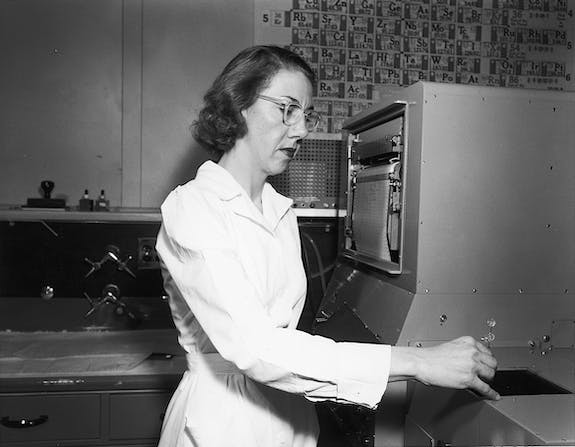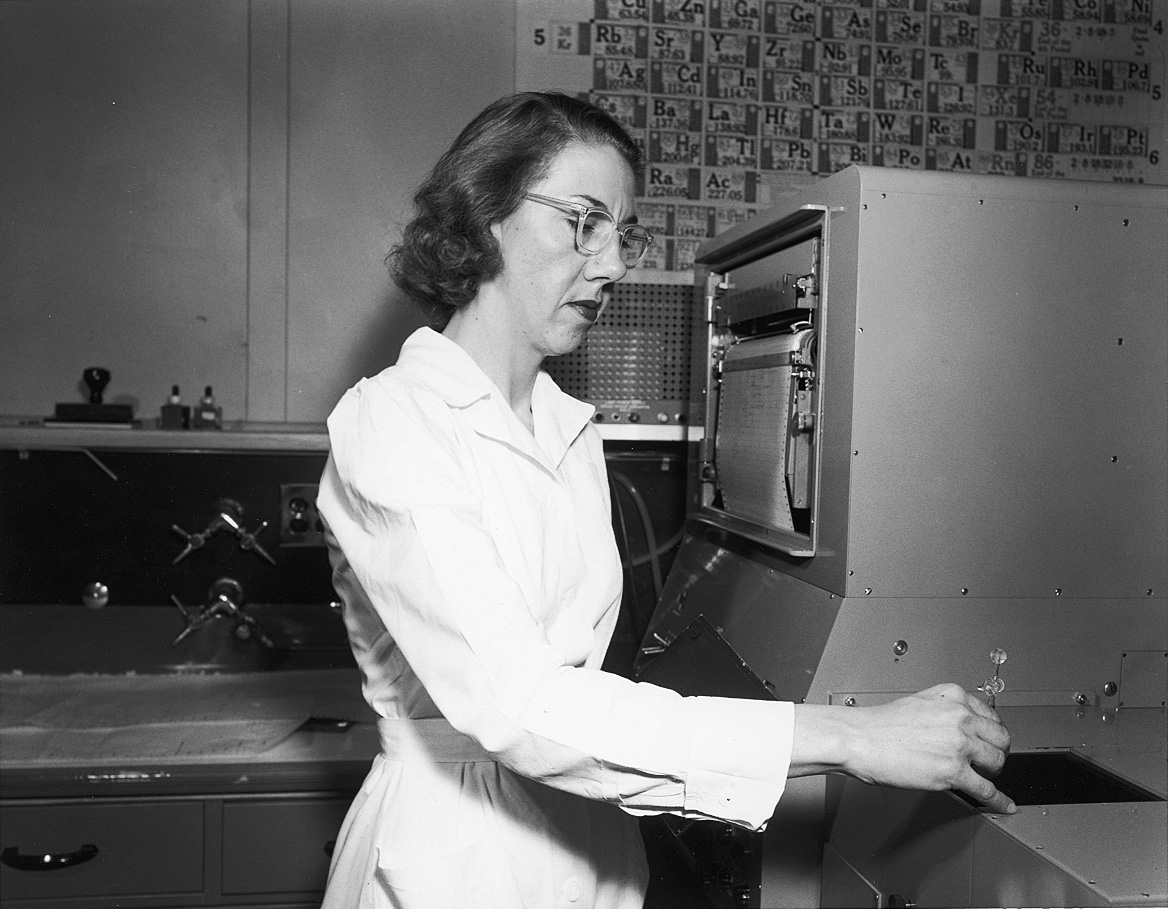Although it might be hard to calculate the total brainpower of Idaho National Laboratory over its 70-plus years of existence, it would be impossible to imagine it at all without the contributions of Bernice Paige.
A chemist who arrived in 1952, Paige retired in 1981 with two patents credited to her. In 1991, she was named the first recipient of the American Nuclear Society’s Mary Jane Oestmann Professional Women’s Achievement Award.
In a time when few women worked at the National Reactor Testing Station, as the Idaho National Laboratory Site was initially called, she was a big personality. “She was gregarious and outspoken – you mostly just listened,” said Phil Anderson, who worked with Paige from 1976 to 1981 at the Idaho Chemical Processing Plant (now the Idaho Nuclear Technology and Engineering Center). “When we had an ‘Idaho reunion’ at an American Nuclear Society conference around 1990, we came up with some different categories to help people reminisce. One of them was just one word: Bernice.”
Paige died in 2013, at the age of 91. In addition to her accomplishments in science, she was a world traveler and adventurer. With her husband, David, also a chemist and engineer, she set foot on all seven continents and visited the Himalayas repeatedly, to trek and work on projects organized by Sir Edmund Hillary.

A native of Iowa, she knew she was bound for college. “I was planning to attend Iowa State no matter what,” she told the school’s alumni magazine in 2001. She had $25 in her pocket and a job at the dime store when dairyman Clifford Stephens (for whom Iowa State’s Stephens Auditorium was later named) was impressed enough with her to give her a scholarship. The $50 she received each quarter helped pay for tuition and some books.
After receiving her bachelor’s degree in chemical technology in 1946, she started looking for a job. “[I] had companies tell me, ‘We’d love to hire you, but we don’t even have a women’s restroom,’” she said. “I wanted to say, ‘I don’t care.’” Finally, during an interview in Buffalo, New York, E. I. du Pont de Nemours and Co. offered her a job on the spot.
“As a woman in the industry, that was very unusual,” she said.
She and her husband worked for DuPont in New York and Delaware and later at the Atomic Energy Commission’s Savannah River Plant. Then, they were recruited by Phillips Petroleum to work at the Chem Plant, as the Idaho Chemical Processing Plant was colloquially known.
Over 35 years, between 1953 and 1988, chemists and engineers at the Chem Plant separated and reprocessed spent reactor fuel, recovering 31,432 kilograms of uranium, as well as radioactive lanthanum, neptunium, krypton and xenon, for use in private industry or at other nuclear operations. Paige was involved in all of it, and the library of Phillips’ Atomic Energy Division is dotted with papers she wrote bearing titles like “Determination of uranium in irradiated thorium” and “Effect of dissolved stainless steel components on vapor-liquid equilibria in aqua-regia.”
“She had so much to say about so many things, some people might have thought she was flighty,” Anderson said. “But her focus was intense. We were all aware of it. Everybody knew who she was.”
Paige filed for her first patent in 1960. Titled “Emulsion control in liquid-suspension extraction,” she and her colleagues Kenneth Rohde and Bill Newby offered an improved solvent-based process for extracting plutonium-239 and uranium-233 from spent nuclear reactor fuel.
“The recovery of such values is, of course, an economic necessity,” they wrote. “[No] reactor now known is able to consume in a single run the fissionable fuel with which it is charged to anywhere near completion, and therefore the unconsumed portion must be recovered if the costs of reactor operation are not to become excessive.”
Her second patent, which she authored herself in 1976, involved another difficult chemical separation – dissolving uranium oxide, zirconium dioxide and calcium oxide wafers used in pressurized water reactor fuel.
Anderson remembers that when he first met Paige in the ‘60s, there were probably only about five women working at the Site as chemists, physicists and radiologists. “There weren’t many, and they weren’t paid as well as men doing the same work,” he said. In fact, when the first effort to level up salaries finally came in the ‘70s, Paige told him she’d never imagined getting such a hefty raise.
Married 61 years, Bernice and David (who died in 2010) were dedicated hikers and backpackers. They were founding members of the Idaho Trails Council and members of both the Lewis and Clark Trail Foundation and Continental Divide Trail Alliance. In Nepal, they helped endow an elementary school and medical clinic for the children of their Sherpa friends.
Paige joined the American Nuclear Society in 1974 and presented numerous papers. As a volunteer, she chaired the ANS Public Information Committee and later the ANS Local Sections Committee, as well as serving in most leadership positions of the large Idaho Section of the ANS. When she received the Women’s Achievement Award, her citation was “For lifetime achievements in the chemistry of nuclear fuel reprocessing and high-level waste management and for pioneering work in underground corrosion evaluation and control.”
Paige never forgot the help she received to get her through school, and in 2001, she and her husband established the Bernice E. Paige Scholarship in Chemical and Biological Engineering at Iowa State, for young female students.
“I had to work a lot while I was taking classes, and I know how hard it is,” she said. “This scholarship will go to kids who can’t make it all the way on their own. … I wouldn’t have anything if someone didn’t help me get my degree.”







